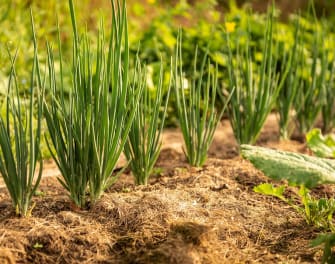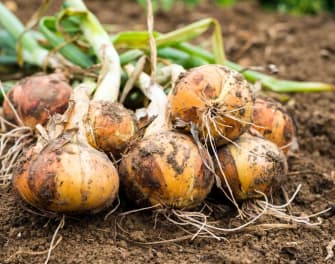Many of us think of Onions as a summer vegetable because it's often harvested later in the season. Onions should always be planted in spring because they require a somewhat long growing season. Planting in the fall is not recommended because the temperatures decline and they perform better when planted at least 2 to 3 months prior to the first frost. Onions prefer to be planted when it's cool, and warm when they mature.

Plant your onions sets in a sunny location and into well drained soil. Use sets that are ½" to ¾" diameter and place them just below the soil line so they're on top of the soil and just barely covered. Space your plants 4-6" apart.
You can also start unique varieties from seeds. I used starter plants instead of bulb sets, just to get comfortable with my first efforts. If you're using bulbs, make sure the pointy side is up or you'll surely have disappointments. Another recommendation I'll share from my first efforts is, I didn't plant enough plants to really enjoy them thoroughly. I didn't have any left for storage.
Although there's never a time when onions aren't ready for harvesting, in order to maximize your yield it's suggested to allow the full growing season and wait for them to stop growing, When you observe the leaves of the onion plant discoloration and falling over, this indicates they've stopped growing.The leaves have completed their purpose and transferred all the stored energy into the bulb. New gardeners often mistake this process with a pest or cultural problem and it's better to do nothing except get ready for harvesting.
Once you've reached this stage of development, you have a couple more weeks that allows the last bit of maturation. Do NOT leave the bulbs in the ground for more than a couple weeks because it exposes them to organisms that cause rotting.

Try to schedule your harvesting on a sunny day when the onions can set in the sun and dry out. This drying out depends on temperatures and shouldn't take more than a day or two. The drying will kill the roots that you can remove by simply pulling or cutting. If you end up harvesting after a lot of rainfall the onions will be water laden and may not dry out as well. This may impact how well they cure.
After the "drying out" period, bring your onions under cover to a warm location but shaded from the sun. This begins the curing process. It's fine to cut the leaves off at this point but it's not required. Never cut the leaves closer than an inch above the bulb or it will impact how well they cure.
Curing should take 2-3 weeks and it's recommended to rotate the onions to facilitate even drying. You don't want any wet spots on the bulbs so be sure to give them a long enough time to cure. If your crop is large enough to consider storing; place them in mesh bags and hang them in your garage, shed or any shaded, dry location. Do not allow them to be rained on. The longer onions cure, the better they can be stored.
As I shared before; the biggest disappointment I had with onions was; I didn't plant enough of them.
I'll look forward to seeing you in the garden.
